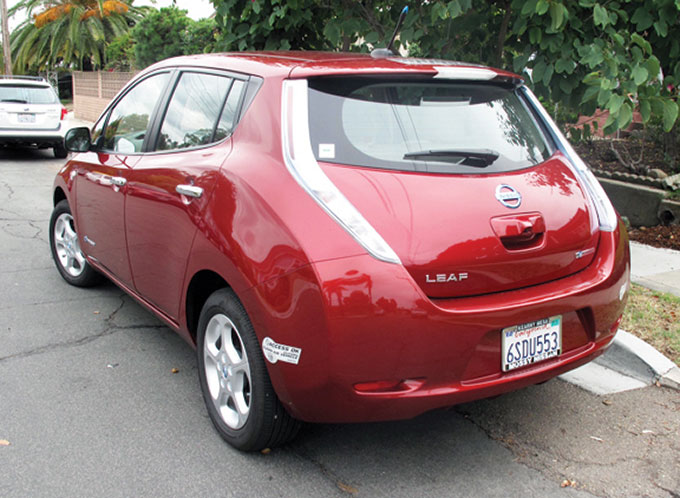Releaf From Gas Pains

The 2012 Nissan Leaf
My brother Dennis lives in San Diego and has owned a Leaf since this past spring. I asked him to write about his experiences with it:
The first question is always “Does it have any guts?” After six months driving my Nissan Leaf, I can’t remember how many times I’ve answered that one. The answer by the way, is a resounding yes. Electric motors provide instant torque; punching the accelerator in this car (do not call it a “gas” pedal) gives the feeling of a launch.
This is no golf cart. It’s a solid-driving, roomy hatchback with lots of luxury car appointments. I’m six feet two inches tall and can easily drive this car wearing a hat. I fit comfortably into the back seat as well, and there’s still plenty of cargo space in the back. The comfortable seats are made with recycled plastic bottles which adds to the car’s green credentials.
A step beyond hybrids, the Leaf is all-electric. No gas tank. No tail pipe. Zero emissions. I laugh as I drive by gas stations. My refueling station is in my garage. I used to spend about $90 per month on gasoline, but my last one-month bill for electricity for the Leaf was $9.06. I also save a lot on maintenance. No engine means no oil changes. No transmission or radiator, either. Just rotate the tires, keep the windshield washer fluid topped off, and change the wiper blades once in a while.
The other question is always “How far can it go on a charge?” Nissan’s estimate of 100 miles average has been pretty close to my personal experience even though I haven’t actually run it from a full charge down to zero. Actual mileage varies depending on how it’s driven. Going fast in regular “drive” mode will use more electricity per mile than using the car’s “eco” mode going slow. Regenerative braking recharges the battery when you brake or coast. Think of the range as something more like 60 miles on the highway to 120 on slower city streets.
But don’t worry too much about that range. Remember, you can fill up again as soon as you get home. Even if you find the battery a little low while away, you can plug in anywhere there’s a 110 outlet for a Level 1 trickle charge. A federal grant is building public charging stations in several test areas, including here in San Diego. Most of those will be 240-volt Level 2 stations like the one in my garage, but some of those will be 480-volt Level 3 Quick Charge stations that can fill you up to an 80 percent charge in about 20 minutes.
I love that the car is so quiet that it needs an electronic sound at low speeds to warn blind people that I’m there. I love the fact that it’s not belching emissions into the air. I work in the conservation business, so I love the fact that the energy it takes to generate the electricity for my drive is far less than my old gas-powered car used. But the best thing about Leaf is that it’s a great car that’s fun to drive.
Just before press time, I got a call that there was a Leaf demo car at Mike Barney Nissan in Amherst, so I headed over for a quick look. I, too, was impressed with driving the car. Of course it’s quiet, but it really moves and handles well; it seems to be made of quality materials; and it’s different-looking enough to stand out in a crowd without looking weird. And I’ve just read that the AAA is adding quick-charge units to some of its rescue trucks in a few test cities, which will go a long way towards relieving any range anxiety of potential buyers. Stop in to Mike Barney and have a look for yourself. Or find more info at nissanusa.com.
Read more of Jim Corbran's You Auto Know every other week in Artvoice, and more frequently on Artvoice Daily.
blog comments powered by Disqus|
Issue Navigation> Issue Index > v10n51 (Week of Thursday, December 22) > Releaf From Gas Pains This Week's Issue • Artvoice Daily • Artvoice TV • Events Calendar • Classifieds |









 Current Issue
Current Issue